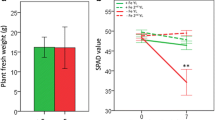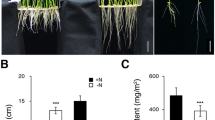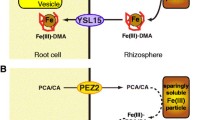Abstract
Typical for a graminaceous plant, barley secretes mugineic acid-family phytosiderophores (MAs) to acquire iron (Fe). Under Fe-deficient conditions, MAs secretion from barley roots increases markedly. Secretion shows a diurnal pattern, with a clear peak 2–3 h after sunrise and cessation within a few hours. Microarray analyses were performed to profile the Fe deficiency-inducible genes in barley roots and diurnal changes in the expression of these genes. Genes encoding enzymes involved in MAs biosynthesis, the methionine cycle, and methionine biosynthesis were highly induced by Fe deficiency. The expression of sulfate transporters was also upregulated by Fe deficiency. Therefore, all of the genes participating in the MAs pathway from sulfur uptake and assimilation to the biosynthesis of MAs were upregulated in Fe-deficient barley roots. In contrast to MAs secretion, the transcript levels of these genes did not show diurnal changes. The amount of endogenous MAs gradually increased during the day after MAs secretion ceased, and was highest before secretion began. These results show that MAs biosynthesis, including the supply of the substrate methionine, occurs throughout the day, and biosynthesized MAs likely accumulate in barley roots until their secretion into the rhizosphere. In contrast, the levels of transcripts encoding an Fe(III)–MAs complex transporter, two putative metal–MAs complex transporters, and HvYS1 were also increased in Fe-deficient barley roots, and the levels of two of these transcripts showed diurnal rhythms. The Fe(III)–MAs complex transporters may absorb Fe(III)–MAs diurnally, synchronous with the diurnal secretion of MAs.



Similar content being viewed by others
Abbreviations
- MAs:
-
Mugineic acid family phytosiderophores
References
Bashir K, Inoue H, Nagasaka S, Takahasshi M, Nakanishi H, Mori S, Nishizawa NK (2006) Cloning and characterization of deoxymugineic acid synthase gene from graminaceous plants. J Biol Chem 281:32395–32402
Buchner P, Takahashi H, Hawkesford MJ (2004) Plant sulphate transporters: co-ordination of uptake, intracellular and long-distance transport. J Exp Bot 55:1765–1773
Curie C, Panaviene Z, Loulergue C, Dellaporta SL, Briat JF, Walker EL (2001) Maize yellow stripe 1 encodes a membrane protein directly involved in Fe(III) uptake. Nature 409:346–349
DiDonato RJ Jr, Roberts LA, Sanderson T, Eisley RB, Walker EL (2004) Arabidopsis Yellow Stripe-Like2 (YSL2): a metal-regulated gene encoding a plasma membrane transporter of nicotianamine–metal complexes. Plant J 39:403–414
Glisin V, Crkvenjakov R, Byus C (1974) Ribonucleic acid isolated by cesium chloride centrifugation. Biochemistry 13:2633–2637
Grossman A, Takahashi H (2001) Macronutrient utilization by photosynthetic eukaryotes and the fabric of interactions. Annu Rev Plant Physiol Plant Mol Biol 52:163–210
Harmer SL, Kay SA (2005) Positive and negative factors confer phase-specific circadian regulation of transcription in Arabidopsis. Plant Cell 17:1926–1940
Harmer SL, Hogenesch JB, Straume M, Chang H-S, Han B, Zhu T, Wang X, Kreps JA, Kay SA (2000) Orchestrated transcription of key pathways in Arabidopsis by the circadian clock. Science 290:2110–2113
Higuchi K, Kanazawa K, Nishizawa NK, Mori S (1996) The role of nicotianamine synthase I response to Fe nutrition status in Gramineae. Plant Soil 178:171–177
Higuchi K, Suzuki K, Nakanishi H, Yamaguchi H, Nishizawa NK, Mori S (1999) Cloning of nicotianamine synthase genes, novel genes involved in the biosynthesis of photosiderophores. Plant Physiol 119:471–479
Higuchi K, Watanabe S, Takahashi M, Kawasaki S, Nakanishi H, Nishizawa NK, Mori S (2001) Nicotianamine synthase gene expression differs in barley and rice under Fe-deficient conditions. Plant J 25:159–167
Jean ML, Schikora A, Mari S, Briat JF, Curie C (2005) A loss-of-function mutation in AtYSL1 reveals its role in iron and nicotianamine seed loading. Plant J 44:769–782
Kanazawa K, Higuchi K, Fushiya S, Nishizawa NK, Chino M, Mori S (1995) Inductions of two enzyme activities involved in the biosynthesis of mugineic acid in Fe-deficient barley roots. In Abadía J (eds) Iron nutrition in soils and plants. Kluwer Academic Press, Dordrecht
Kobayashi T, Nakanishi H, Takahashi M, Kawasaki S, Nishizawa NK, Mori S (2001) In vivo evidence that Ids3 from Hordeum vulgare encodes a dioxygenase that converts 2′-deoxymugineic acid to mugineic acid in transgenic rice. Planta 212:864–871
Kobayashi T, Nakayama Y, Itai RN, Nakanishi H, Yoshihara T, Mori S, Nishizawa NK (2003) Identification of novel cis-acting elements, IDE1 and IDE2, of the barley IDS2 gene promoter conferring iron-deficiency-inducible, root-specific expression in heterogeneous tobacco plants. Plant J 36:780–793
Kobayashi T, Suzuki M, Inoue H, Itai RN, Takahashi M, Nakanishi H, Mori S, Nishizawa NK (2005) Expression of iron-acquisition-related genes in iron-deficient rice is coordinately induced by partially conserved iron-deficiency-responsive elements. J Exp Bot 56:1305–1316
Kobayashi T, Ogo Y, Nakanishi RI, Nakanishi H, Takahashi M, Mori S, Nishizawa NK (2007) The transcription factor IDEF1 regulates the response to and tolerance of iron deficiency in plants. Proc Natl Acad Sci USA 104:19150–19155
Koike S, Inoue H, Mizuno D, Takahashi M, Nakanishi H, Mori S, Nishizawa NK (2004) OsYSL2 is a rice metal-nicotianamine transporter that is regulated by iron and expressed in the phloem. Plant J 39:415–424
Ma JF, Shinada T, Matsuda C, Nomoto K (1995) Biosynthesis of phytosiderophores, mugineic acids, associated with methionine cycling. J Biol Chem 270:16549–16554
Ma JF, Taketa S, Chang YC, Iwashita T, Matsumoto H, Takeda K, Nomoto K (1999) Genes controlling hydroxylations of phytosiderophores are located on different chromosomes in barley (Hordeum vulgare L.). J Plant Nutr 14:341–361
Marschner H, Römheld V, Kissel M (1986) Different strategies in higher plants in mobilization and uptake of iron. J Plant Nutr 9:695–713
Michael TP, McClung CR (2002) Phase-specific circadian clock regulatory elements in Arabidopsis thaliana. Plant Physiol 130:627–638
Michael TP, McClung CR (2003) Enhancer trapping reveals widespread circadian clock transcriptional control in Arabidopsis. Plant Physiol 132:629–639
Mori S, Nishizawa NK (1987) Methionine as a dominant precursor of phytosiderophore in graminaceae plant. Plant Cell Physiol 28:1081–1092
Murata Y, Ma JF, Yamaji N, Ueno D, Nomoto K, Iwashita T (2006) A specific transporter for iron(III)-phytosiderophore in barley roots. Plant J 46:563–572
Nakanishi H, Yamaguchi H, Sasakuma T, Nishizawa NK, Mori S (2000) Two dioxygenase genes, Ids3 and Ids2, from Hordeum vulgare are involved in the biosynthesis of mugineic acid family phytosiderophores. Plant Mol Biol 44:199–207
Negishi T, Nakanishi H, Yazaki J, Kikuchi S, Mori S, Nishizawa NK (2002) cDNA microarray analysis of gene expression during Fe-deficiency stress in barley suggests that polar transport of vesicles is implicated in phytosiderophore secretion in Fe-deficient barley roots. Plant J 30:83–94
Nozoye T, Itai RN, Nagasaka S, Takahashi M, Nakanishi H, Mori S, Nishizawa NK (2004) Diurnal changes in the expression of genes that participate in phytosiderophore synthesis in rice. Soil Sci Plant Nutr 50:1125–1131
Römheld V, Marschner H (1990) Genotypical differences among graminaceous species in release of phytosiderophores and uptake of iron phytosiderophores. Plant Soil 123:147–153
Schaaf G, Schikora A, Häberle J, Vert G, Ludewig U, Briat JF, Curie C, von Wíren N (2005) A putative function for the Arabidopsis Fe-phytosiderophore transporter homolog AtYSL2 in Fe and Zn homeostasis. Plant Cell Physiol 46:762–774
Shibagaki N, Rose A, McDermott JP, Fujiwara T, Hayashi H, Yoneyama T, Davies JP (2002) Selenate resistant mutants of Arabidopsis thaliana identify Sultr1;2, a sulfate transporter required for efficient transport of sulfate into roots. Plant J 29:475–486
Shojima S, Nishizawa NK, Fushiya S, Nozoe S, Irifune T, Mori S (1990) Biosynthesis of phytosiderophores. In-vitro biosynthesis of 2′-deoxymugineic acid from l-methionine and nicotianamine. Plant Physiol 93:1497–1503
Takagi S (1976) Naturally occurring iron-chelating compounds in oat- and rice-root washings. Soil Sci Plant Nutr 22:423–433
Takagi S, Nomoto K, Takemoto S (1984) Physiological aspect of mugineic acid, a possible phytosiderophore of graminaceous plants. J Plant Nutr 7:469–477
Takahashi M, Yamaguchi H, Nakanishi H, Shioiri T, Nishizawa NK, Mori S (1999) Cloning two genes for nicotianamine aminotransferase, a critical enzyme in iron acquisition (strategy II) in graminaceous plants. Plant Physiol 121:947–956
Thimm O, Essigmann B, Kloska S, Altmann T, Buckhout TJ (2001) Response of Arabidopsis to iron deficiency stress as revealed by microarray analysis. Plant Physiol 127:1030–1043
Vauclare P, Kopriva S, Fell D, Suter M, Sticheer L, von Ballmoos P, Krähenbühl U, den Camp RO, Brunold C (2002) Flux control of sulphate assimilation in Arabidopsis thaliana: adenosine 5′-phosphosulphate reductase is more susceptible than ATP sulphurylase to negative control by thiols. Plant J 31:729–740
Wang YH, Garvin DF, Kochian LV (2002) Rapid induction of regulatory and transporter genes I response to phosphorus, potassium, and iron deficiencies in tomato roots. Evidence for cross talk and root/rhizosphere-mediated signals. Plant Physiol 130:1361–1370
Wintz H, Fox T, Wo Y-Y, Feng V, Chen W, Chang H-S, Zhu T, Vulpe C (2003) Expression profiles of Arabidopsis thaliana in mineral deficiencies reveal novel transporters involved in metal homeostasis. J Biol Chem 278:47644–47653
Yamaguchi H, Nakanishi H, Nishizawa NK, Mori S (2000a) Induction of the IDI1 gene in Fe-deficient barley roots: a gene encoding putative enzyme that catalyses the methionine salvage pathway for phytosiderophore production. Soil Sci Plant Nutr 46:1–9
Yamaguchi H, Nakanishi H, Nishizawa NK, Mori S (2000b) Isolation and characterization of IDI2, a new Fe-deficiency induced cDNA from barley roots, which encodes a protein related to the α-subunit of eukaryotic initiation factor 2B (eIF2B). J Exp Bot 51:2001–2007
Yoshimoto N, Takahashi H, Smith FW, Yamaya T, Saito K (2002) Two distinct high-affinity sulfate transporters with different inducibilities mediate uptake of sulfate in Arabidopsis roots. Plant J 29:465–476
Author information
Authors and Affiliations
Corresponding author
Rights and permissions
About this article
Cite this article
Nagasaka, S., Takahashi, M., Nakanishi-Itai, R. et al. Time course analysis of gene expression over 24 hours in Fe-deficient barley roots. Plant Mol Biol 69, 621–631 (2009). https://doi.org/10.1007/s11103-008-9443-0
Received:
Accepted:
Published:
Issue Date:
DOI: https://doi.org/10.1007/s11103-008-9443-0




